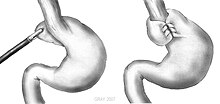Fundoplication
A fundoplication or fundoplication is an operation used to treat reflux esophagitis or a hiatal hernia .
technology
The operation can be performed both openly and laparoscopically ( laparoscopy ). As part of the procedure, parts of the gastric fundus are loosely wrapped around the lower esophageal sphincter and fixed with a suture. The aim is to provide additional support for the sphincter muscle through the pressure of the cuff when the stomach is filled after eating. This prevents the gastric contents from flowing back into the esophagus, causing the disease.
indication
Fundoplication is indicated in patients with reflux esophagitis who do not respond adequately to drug therapy with high-dose proton pump inhibitors and in hiatal hernias.
Prospects for recovery and complications
Around 90% of the treated cases show healing of the esophagitis. Possible complications are passage problems, dumping syndrome , loosening of the cuff with recurrence of reflux. In addition, the cuff preventing belching can lead to a feeling of fullness in the left upper abdomen. Stomach volvulus can occur as a rare complication .
Medical history
The fundoplication was developed and established by the German surgeon Rudolf Nissen (published 1956). Further development to the 270-degree fundoplication (hemiplication, incomplete cuff around the abdominal part of the esophagus ) was carried out by the French Andre Toupet (published 1963). Further variants are the laparoscopic ventral hemiplication with 150 ° to 200 ° according to Jacques Dor (1962) and Thal (1968) with 90 ° (anterior hemiplication).
